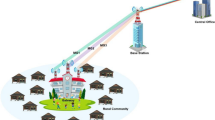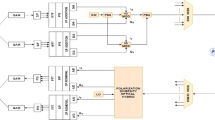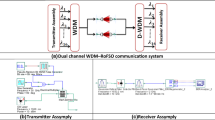Abstract
The increasing demand for high-speed information transmission as a result of adoption of wide variety of multimedia applications including high-definition television, social networking, and live streaming etc. has challenged the service providers. The conventional wireless transmission systems based on radio frequency are unable to meet the high channel capacity requirements. We design and demonstrate a novel radio-over-free space optics (RoFSO) communication system using hybrid wavelength- and mode-division multiplexing (WDM-MDM). The present RoFSO system consists of four transmitter subsections, four-channel MDM multiplexer/demultiplexer, four-channel WDM multiplexer/demultiplexer, and four receiver subsections. Each channel uses four distinct spatial modes (HG00, HG01, HG02, and HG11) which transport independent 10-Gb/s-10-GHz information over a wavelength range of 850–852.4 nm. We achieved a net system transmission rate of [4 \(\lambda \times\) (4 modes) \(\times\) (10 Gb/s-10 GHz)] i.e. 160-Gb/s-160-GHz. Also, we demonstrate the WDM-MDM-based RoFSO link performance and availability under clear and dust weather conditions using bit error rate, maximum reachable link range and eye diagrams as key performance evaluation parameters. The results showed a successful data transfer through 8 km clear weather free-space channel and 88 m dense dust weather conditions, respectively. Subsequently, the results show the feasibility of presented system in the implementation of high-speed ultra-dense cellular/data 5G networks (above 6 GHz) and smart city applications.













Similar content being viewed by others
Code availability
This work was performed using Optisystem tool.
References
Kumar, A., & Krishnan, P. (2020). Performance analysis of RoFSO links with spatial diversity over combined channel model for 5G in smart city applications. Optics Communication, 466, 125600. https://doi.org/10.1016/j.optcom.2020.125600
Shafi, M., Jha, R. K., & Sabraj, M. (2020). A survey on security issues of 5G NR: Perspective of artificial dust and artificial rain. Journal of Network and Computer Applications, 160, 102597. https://doi.org/10.1016/j.jnca.2020.102597
Singh, M., & Malhotra, J. (2020). Performance comparison of 2 × 20 Gbit/s-40 GHz OFDM based RoFSO transmission link incorporating MDM of hermite gaussian modes using different modulation schemes. Wireless Personal Communications, 110, 699–711.
Singh, M., & Malhotra, J. (2019). Performance investigation of high-speed FSO transmission system under the influence of different atmospheric conditions incorporating 3-D orthogonal modulation scheme. Optical and Quantum Electronics, 51, 285. https://doi.org/10.1007/s11082-019-1998-2
Pottoo, S. N., Goyal, R., & Gupta, A. (2020). Design and investigation of free space optical system for diverse atmospheric transmission windows. Journal of Optical Communications. https://doi.org/10.1515/joc-2020-0023
Grover, A., Sheetal, A., & Dhasarathan, V. (2020). Performance analysis of mode division multiplexing based free space optics system incorporating on–off keying and polarization shift keying under dynamic environmental conditions. Wirel. Networks, 26(5), 3439–3449. https://doi.org/10.1007/s11276-020-02275-6
Singh, M., & Malhotra, J. (2019). Performance comparison of M-QAM and DQPSK modulation schemes in a 2 × 20 Gbit/s–40 GHz hybrid MDM–OFDM-based radio over FSO transmission system. Photonic Netw. Commun., 38(3), 378–389. https://doi.org/10.1007/s11107-019-00861-z
Singh, M., & Malhotra, J. (2020). Performance Comparison of Different Modulation Schemes in High-Speed MDM Based Radio Over FSO Transmission Link Under the Effect of Atmospheric Turbulence Using Aperture Averaging. Wireless Personal Communications, 111, 825–842. https://doi.org/10.1007/s11277-019-06886-x
Tian, Y., Li, J., Wu, Z., Chen, Y., Zhu, P., Tang, R., Mo, Q., He, Y., & Chen, Z. (2017). Wavelength-interleaved MDM-WDM transmission over weakly-coupled FMF. Optics Express, 25(14), 16603–16617. https://doi.org/10.1364/OE.25.016603
Cao, M., Wang, H., Yao, Y., & Hou, S. (2019). Performance evaluation of FSO communications under sand-dust conditions. International Journal of Antennas and Propagation, 2019, 1–11. https://doi.org/10.1155/2019/2046896
Jiang, M., Chen, C., Zhu, B., & Hu, F. (2020). MIMO-free WDM–MDM bidirectional transmission over OM3 MMF. Optics Communications, 473, 125988. https://doi.org/10.1016/j.optcom.2020.125988
Wu, Z., Li, J., Ge, D., Ren, F., Zhu, P., Mo, Q., Li, Z., Chen, Z., & He, Y. (2016). Demonstration of all-optical MDM/WDM switching for short-reach networks. Optics Express, 24(19), 21609–21618. https://doi.org/10.1364/oe.24.021609
Singh, M., & Malhotra, J. (2020). 4×20-Gbit/s-40GHzOFDM based radio over FSO transmission link incorporating hybrid wavelength division multiplexing-mode division multiplexing of LG and HG modes with enhanced detection. Optoelectronics and Advanced Materials, Rapid Communications, 14(5–6), 233–243.
Algamal, A. A., Fayed, H. A., Mahmoud, M., & Aly, Moustafa H. (2020). Reliable FSO system performance matching multi-level customer needs in Alexandria City, Egypt, climate: sandstorm impact with pointing error. Optical and Quantum Electronics, 52(7), 1–18. https://doi.org/10.1007/s11082-020-02468-5
Ahmad, H., Soltanian, M. R. K., Amiri, I. S., Alavi, S. E., Othman, A. R., & A. S. M. Supa’at, . (2015). “Carriers generated by mode-locked laser to increase serviceable channels in radio over free space optical systems. IEEE Photonics Journal, 7(5), 1–12. https://doi.org/10.1109/JPHOT.2015.2484285
A. Ghatak and K. Thyagarajan (1998) An introduction to fiber optics, Cambridge University Press, Cambridge. doi: https://doi.org/10.1017/CBO9781139174770
M. A. A. Ali, Z. H. Baqi, and S. K. Rahi (2020) “On the performance of free space optical communication link over dust environment,”In AIP Conf. Proc., 2nd international conference on materials engineering and science (IConMEAS-2019), Baghdad, Iraq, vol. 2213, Article ID-020105. doi: https://doi.org/10.1063/5.0000241
Bohren, C. F., & Huffman, D. R. (1998). Absorption and scattering of light by small particles. A Wiley-Interscience Publication. https://doi.org/10.1002/9783527618156
Saleem, M., Awan, G., Csurgai, L., Sheikh, S., Saeed, M., & Khan, G. (2009). Characterization of fog and snow attenuations for free-space optical propagation. The Journal of Communication, 4(8), 533–545. https://doi.org/10.4304/jcm.4.8.5
Z. Ghassemlooy, J. Perez, and E. Leitgeb (2013)“On the performance of FSO communications links under sandstorm conditions,”In Proc. 12th international conference telecommunication ConTEL, Zagreb, pp. 53–58
Esmail, M. A., Fathallah, H., & Alouini, M. S. (2016). An experimental study of FSO link performance in desert environment. IEEE Communications Letters, 20(9), 1888–1891. https://doi.org/10.1109/LCOMM.2016.2586043
Baddock, M. C., Strong, C. L., Leys, J. F., Heidenreich, S. K., Tews, E. K., & McTainsh, G. H. (2014). A visibility and total suspended dust relationship. Atmospheric Environment, 89, 329–336. https://doi.org/10.1016/j.atmosenv.2014.02.038
Wang, W. C., Wang, H. Y., & Lin, G. R. (2018). Ultrahigh-speed violet laser diode based free-space optical communication beyond 25 Gbit/s. Science and Reports, 8(1), 4–10. https://doi.org/10.1038/s41598-018-31431-4
Majumdar, A. K. (2015). Fundamentals of free-space optical (FSO) communication system. Springer Series in Optical Sciences, 186, 1–20. https://doi.org/10.1007/978-1-4939-0918-6_1
Bloom, S., Korevaar, E., Schuster, J., & Willebrand, H. (2003). Understanding the performance of free-space optics. Journal of Optical Networking, 2(6), 178–200. https://doi.org/10.1364/JON.2.000178
M. Singh, J. Malhotra, A. Atieh, H.J. El-Khozondar, and V. Dhasarathan (2020) Performance investigation of 1.6 Tbps hybrid WDM-PDM-OFDM-based free space optics transmission link. Wireless Personal Communication. doi: https://doi.org/10.1007/s11277-020-07972-1
Kazovsky, L. G. (1985). Optical heterodyning versus optical homodyning: A comparison. Journal of Optical Communication, 6(1), 18–24. https://doi.org/10.1515/JOC.1985.6.1.18
Kharraz, O., & Forsyth, D. (2013). Performance comparisons between PIN and APD photodetectors for use in optical communication systems. Optik, 124(13), 1493–1498. https://doi.org/10.1016/j.ijleo.2012.04.008
Ali, M. A. A. (2014). Comparison of NRZ, RZ-OOK modulation formats for FSO communications under fog weather condition. International Journal of Computers and Applications, 108(2), 29–34. https://doi.org/10.5120/18885-0164
Giuliano, G., Laycock, L., Rowe, D., & Kelly, A. E. (2017). Solar rejection in laser based underwater communication systems. Optics Express, 25(26), 33066–33077. https://doi.org/10.1364/oe.25.033066
Alhaider, M. A. (1986). Radio wave propagation into sandstorms-system design based on ten-years visibility data in Riyadh, Saudi Arabia. International Journal of Infrared and Millimeter Waves, 7(9), 1339–1359. https://doi.org/10.1007/BF01012054
Alnajjar, S. H., Noori, A. A., & Moosa, A. A. (2017). Enhancement of FSO communications links under complex environment. Photonic Sensors, 7(2), 113–122. https://doi.org/10.1007/s13320-017-0336-1
M. A. Esmail, H. Fathallah, and M. S. Alouini (2016) “Effect of dust storms on FSO communications links,”In 4th International conference of control engineering information technology CEIT 2016, Hammamet, Tunisia, pp. 1–6. doi: https://doi.org/10.1109/CEIT.2016.7929046
Mazin, M. A., Shaker, F. K., & Kadhum, H. A. (2020). Investigation and analysis of data rate for free space optical communications system under dust conditions. Wireless Personal Communications, 113(4), 2327–2338. https://doi.org/10.1007/s11277-020-07328-9
Funding
No funding was received for this work.
Author information
Authors and Affiliations
Corresponding authors
Ethics declarations
Conflict of interest
The authors declare that they donot have any conflict of interest.
Additional information
Publisher's Note
Springer Nature remains neutral with regard to jurisdictional claims in published maps and institutional affiliations.
Rights and permissions
About this article
Cite this article
Singh, M., Pottoo, S.N., Suvidhi et al. A high-speed radio over free space optics transmission link under dust environment conditions employing hybrid wavelength- and mode-division multiplexing. Wireless Netw 27, 4875–4888 (2021). https://doi.org/10.1007/s11276-021-02774-0
Accepted:
Published:
Issue Date:
DOI: https://doi.org/10.1007/s11276-021-02774-0




